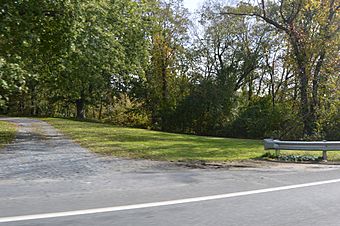Frey-Haverstick Site facts for kids
Quick facts for kids |
|
|
Frey-Haverstick Site (36LA6)
|
|

Land along the stream
|
|
| Location | Eastern side of the Susquehanna River, north of Staman's Run, Washington Boro, Manor Township, Pennsylvania |
|---|---|
| Area | 10.3 acres (4.2 ha) |
| NRHP reference No. | 86000819 |
| Added to NRHP | January 15, 1986 |
The Frey-Haverstick Site (also known as 36LA6) is a very old and important place in Manor Township, Lancaster County, Pennsylvania. It's an archaeological site, which means it's a spot where scientists called archaeologists dig to find clues about people who lived long ago. This site has helped us learn about different groups of people who lived there over thousands of years.
Contents
Discovering the Past at Frey-Haverstick
The Frey-Haverstick Site is located on the eastern side of the Susquehanna River. It's a special place because it holds secrets from both prehistoric times (before written history) and historic times (when people started writing things down). Archaeologists have found many interesting things here.
Digging Up History: The Excavations
Archaeologists have carefully dug at the Frey-Haverstick Site several times. The first official dig happened in 1931. Later, more excavations took place in 1971 and 1975. These digs were carried out by the Pennsylvania Historical and Museum Commission. Their hard work helped uncover many amazing artifacts.
Treasures from the Ground: Amazing Artifacts
People started finding artifacts at this site as early as 1873. An artifact is any object made or used by humans in the past. One of the most exciting finds was a helmet from Sweden! This helmet dates back to the time of King Gustavus II Adolphus, who ruled from 1611 to 1632. Finding a Swedish helmet in Pennsylvania shows how far-reaching connections could be, even centuries ago.
Who Lived Here? Different Cultures Over Time
The Frey-Haverstick Site was home to several different groups of people over a very long period. It shows us how different cultures used the same land.
- Susquehannock Cemetery: Part of the site is a cemetery belonging to the Susquehannock people. They were a Native American group who lived in this area. A cemetery is a burial ground where people laid their loved ones to rest.
- Middle Woodland Habitation Site: There's also a "habitation site" from the Middle Woodland period. A habitation site is simply a place where people lived. The Middle Woodland period was a time in North American history, roughly from 200 BC to 500 AD.
- Shenks Ferry Village: Another part of the site was a village used by the Shenks Ferry culture. This was another group of people who lived in Pennsylvania before European settlers arrived.
The artifacts found at Frey-Haverstick tell us that people were active at this site for a very long time. Their presence spans from about 3500 BC all the way to 1650 AD. That's over 5,000 years of history!
A Protected Place: National Register of Historic Places
Because of its rich history and important archaeological finds, the Frey-Haverstick Site was added to the National Register of Historic Places in 1986. This is a special list kept by the United States government. It helps protect important historical and archaeological sites across the country. Being on this list means the site is recognized as a valuable part of our shared heritage.



